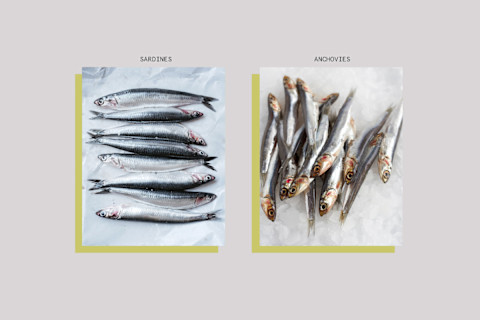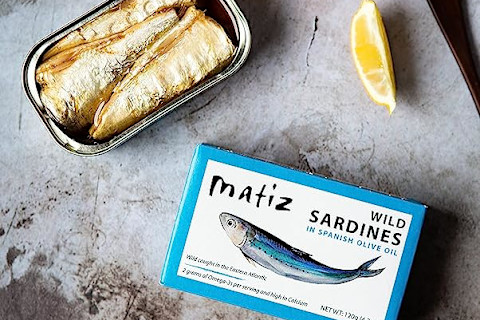Anchovies vs. Sardines: How To Tell The Difference Between These Nutrient-Packed Fish

Fish are an excellent source of protein, fatty acids, and nutrients. Canned varieties in particular are having a moment, with sardines and anchovies being two of the most popular.
And while they share some similarities, they're two distinct fish—each with its own flavor, texture, and nutritional profile.
We reached out to seafood industry insiders and nutrition experts to get the scoop on the differences between sardines and anchovies and how to buy and prepare each.
Anchovies vs. sardines at a glance
Anchovies and sardines are both small fish that swim in schools in temperate to warm waters. You'll often find them shoaling or swimming in a circle as a group to protect themselves from predators.
Both fish are filter feeders that move with their mouths open to catch plankton and nutrients suspended in the water. (The Spanish word for "anchovies," boquerónes, actually translates to "big mouth.")
There are various types of sardines and anchovies caught around the world—from the Engraulis encrasicolus anchovies of Europe and Africa to the Sardinops melanostictus sardines of Japan—and each has unique qualities. In general, though, sardines (6-12 inches) are larger than anchovies (4-10 inches). They also tend to be lighter silver in color, while anchovies can have darker scales tinged with blue or green.
Sardines and anchovies have a similar nutrition profile, though sardines tend to be slightly higher in protein, fat, and calories1.
Both fish have a mild fishy flavor and firm texture when eaten fresh. However, "as soon as you can them, they become different products," Bart van Olphen, the co-founder of Sea Tales and author of The Tinned Fish Cookbook, tells mindbodygreen.
That's because while sardines are lightly smoked or cooked before going in the can, anchovies are cured in salt for months. This salt curing is what gives canned anchovies their brown appearance and salty bite: When eaten fresh from the water, they're actually more comparable to sardines.
You can find anchovies and sardines canned in water or oil (most often olive oil or vegetable oil), served whole or as boneless, skinless filets—sometimes with added flavorings like garlic or chili.
Canned sardines have a shelf life of upward of four to five years, while cured anchovies tend to last about a year. Because of their curing process, van Olphen notes that anchovies should be stored in the refrigerator, not the pantry.
Canned sardines should be enjoyed within a day of opening2, but opened anchovies will stay good for up to two months.
Here's a deeper dive into each fish and how to use it.
Summary
Anchovies
- Size: 4-10 inches
- Canning process: Salt cured
- Shelf life: 1 year
- Flavor profile: Mild & delicate (fresh), salty & abrasive (canned)
Anchovies swim in salty waters all over the world, but most of the ones you'll see on shelves are from Morocco, Peru, and Italy.
Anchovies are packed with omega-3 fats that are essential for brain health and heart health3. They're also a good source of selenium4, a mineral that supports a healthy metabolism5 and enhances thyroid function6.
Since anchovies are so small, they're less likely to contain mercury and other pollutants7 that accumulate in fish higher up the food chain like tuna. "There is a much lower risk of mercury toxicity [with anchovies], so it's safer to be eating these guys more frequently," says registered dietitian Jess Cording, M.S., R.D., CDN.
In addition to salt-cured anchovies, you can also find some that have been preserved in a vinegar mixture. These are often called "white anchovies" in the U.S. because their flesh stays a white color through the canning process. White anchovies are more expensive than traditional anchovies, and they're a bit less common on shelves.
Both types of anchovies are usually preserved in oil—though you can find them packaged in water too.
Buying tips
Opt for anchovies packed in extra-virgin olive oil when you can—they'll pack the most antioxidant, anti-inflammatory polyphenols. Those who are watching their salt intake may want to opt for lower-sodium white anchovies and use traditional anchovies sparingly as a garnish or flavor enhancer.
How to use them
Traditional canned anchovies pack an intensely salty, fishy flavor, so a little goes a long way. But these little fish are good for so much more than Caesar dressing: Cording enjoys using them as a topper for homemade pizza or dressed-up avocado toast to lend an extra hit of brine.
They can also make a punchy touch to pan con tomate (slow-cooked tomatoes on toast), van Olphen notes.
Not a fan of their texture? Anchovies practically melt when cooked, so simmer them down in your favorite sauce or soup recipe for a more subtle addition.
Here are some other recipes that showcase this salty, nutrient-packed ingredient:
Sardines
- Size: 6-12 inches
- Canning process: Cooked
- Shelf life: 4-5 years
- Flavor profile: Firm & fishy
One of the most popular types of sardines, Sardina pilchardus, hail from the Mediterranean, but you can also find sardines from the Baltic region (Spratis Spratis), Japan (Sardinops melanostictus), and beyond.
As Bill Carvalho, the president and founder of Wild Planet Foods, explains, in the U.S., any small silvery forage fish can technically be called a sardine when it's in a can, so species like herring can also fall under the sardine umbrella.
Most canned sardines have their heads removed but retain their skin and small bones. There are also boneless, skinless varieties that come packaged in oil or water.
One can of sardines packs nearly four times the RDA for vitamin B12, which is essential for energy production and the formation of red blood cells8. Sardines are also a healthy source of magnesium, zinc, iron, phosphorous, and other nutrients that have been shown in research to combat oxidative stress and cardiovascular disease9. Like anchovies, sardines are naturally lower in mercury.
Buying tips
Whole sardines are more nutritious than boneless skinless varieties since the skin is packed with healthy fats, and the small bones are a good source of calcium. Carvalho notes that a can of skinless, boneless sardines has about half the omega-3s and one-quarter of the calcium of a can of skin-on, bone-in sardines.
Cording prefers to buy sardines that are packed in extra-virgin olive oil. Again, this type of oil will be healthier than something like grapeseed oil10.
If you plan to add oil to your sardines once they're out of the can—say if you're tossing them in mayonnaise or a homemade dressing—buy them in water.
How to use them
"Sardines are a really nutritious ingredient that's full of flavor, so you don't really need to do too much to them," van Olphen says.
Sardines dry out quickly when cooked, so you'll want to eat them at room temp or wait until the last phase of your recipe to throw them in.
From there, the sky is the limit: van Olphen has used the flavorful forage fish in everything from leek tarts to bean purées. Carvalho is partial to sardine "finger sushi"—a quick snack of nori-wrapped sardines dressed with a bit of wasabi or tamari—and healthier sardine Reubens—which is sandwich sardines, horseradish, Dijon mustard, and sauerkraut between whole grain bread.
For a simple protein-packed salad, Cording likes to combine sardines, avocado, and an acidic dressing. "The avocado is creamy and mild, and it provides a nice balance to the pungency of the sardines," she says. "Adding some kind of acid like lemon juice or your favorite vinegar can be a nice complement too."
Is one healthier?
Sardines and anchovies have slightly different nutritional profiles depending on where they come from. "The ocean in which that fish swims constitutes the nutritional power of the fish because it's all about what it eats, how much it eats, how rich the oceans are," Carvalho explains. That said, here's a nutritional breakdown of one can of whole sardines1 vs. one can of anchovies4, per the USDA:
| Fish | Anchovy (1 can) | Sardines (1 can) |
|---|---|---|
| Calories | 95 | 191 |
| Protein | 13 grams | 23 grams |
| Fat | 4 grams | 11 grams |
| Sodium | 1650 milligrams | 282 milligrams |
| Vitamin B-12 | 0.396 micrograms | 8 micrograms |
| Magnesium | 31 milligrams | 36 milligrams |
| Zinc | 1.1 milligrams | 1.2 milligrams |
| Iron | 2 milligrams | 3 milligrams |
| Phosphorous | 113 milligrams | 451 milligrams |
So, is one healthier than the other? Sardines are higher in protein, calories, and fat per serving, and they contain more vitamin B12 as well as trace minerals like magnesium, zinc, iron, and phosphorous. Canned anchovies have five times more sodium than sardines, due to their unique processing. However, anchovies are a bit more nutrient-dense than sardines thanks to their small size.
While sardines may have a slight nutritional edge over anchovies, one isn't necessarily better than the other, and they both deserve a place on your plate.
Cording notes that both sardines and anchovies are wonderful sources of vitamin D, omega-3s, and various B vitamins. And both are low in mercury and other pollutants (though, alas, they still likely have microplastics in them11).
She usually advises clients to eat fish around two to four times a week and notes that both sardines and anchovies can be great for filling this quota.
Summary
Sustainability of sardines and anchovies
Anchovies and sardines are both considered sustainable protein sources. They fall under the "SMASH" category of fish (salmon, mackerel, anchovies, sardines, and herring) that many health experts love for their fatty acid content and environmental perks.
Eating these lower-on-the-food-chain SMASH fish helps relieve pressure on larger fish like tuna, which are frequently overharvested. Since anchovies and sardines are both relatively short-lived, their stocks also tend to rebound pretty quickly.
Both fish are less carbon-intensive to catch than larger species, especially those grown on fish farms. One study estimates that if Europeans swapped two servings of fish for small blue fish (which includes anchovies, sardines, and herring) a week, it would reduce the greenhouse gas emissions of fish consumption on the continent by an impressive 82%12.
"When I speak about sustainability with anybody, my comment is that every anchovy and sardine in the market is a good choice for sustainability because you're eating directly from the bottom of the food chain," says Carvalho.
Anchovies and sardines are both common ingredients in fishmeal. But think of it this way: Instead of converting these fish to products that feed other protein sources, why not eat them directly—and reap the impressive health benefits of doing so?
Summary
FAQ
Can I replace anchovies with sardines in a recipe?
If you're buying white anchovies that have not been salt-cured, yes! They will be a good stand-in for the firm, fishy sardine. They might be a bit smaller, though, so adjust the recipe serving size accordingly. Salt-cured anchovies out of a can are much saltier and more pungent than sardines and will not make a good substitute. You're better off using herring or mackerel instead.
How do you cook sardines?
Sardines can dry out very quickly, so you don't want to cook them for too long. Instead, use them as a salad topper, sandwich ingredient, or showcase them in a seafood pasta.
The takeaway
Sardines and anchovies are both small, filter-feeding fish that are packed with nutrients and sustainable to eat. However, they are usually prepared differently, and canned anchovies are much higher in sodium than canned sardines.
12 Sources
- https://fdc.nal.usda.gov/fdc-app.html#/food-details/175139/nutrients
- https://pubmed.ncbi.nlm.nih.gov/35407078/
- https://pubmed.ncbi.nlm.nih.gov/25720716/
- https://fdc.nal.usda.gov/fdc-app.html#/food-details/174183/nutrients
- https://www.ncbi.nlm.nih.gov/pmc/articles/PMC5758946/
- https://ods.od.nih.gov/factsheets/Selenium-HealthProfessional/
- https://pubmed.ncbi.nlm.nih.gov/36900577/
- https://ods.od.nih.gov/factsheets/VitaminB12-HealthProfessional/
- https://pubmed.ncbi.nlm.nih.gov/37143475/
- https://pubmed.ncbi.nlm.nih.gov/36276547/
- https://pubmed.ncbi.nlm.nih.gov/36336179/
- https://pubmed.ncbi.nlm.nih.gov/37087360/








